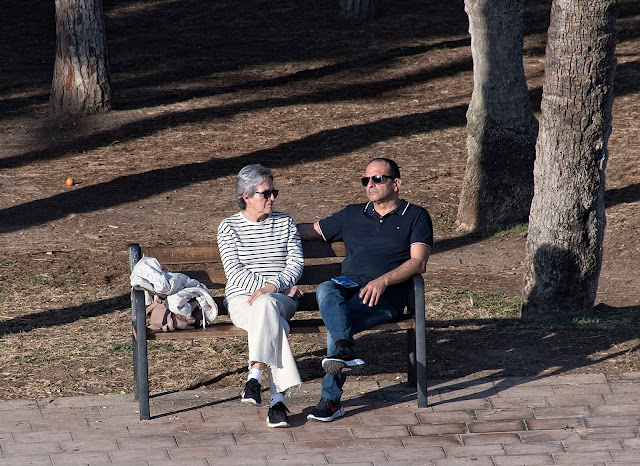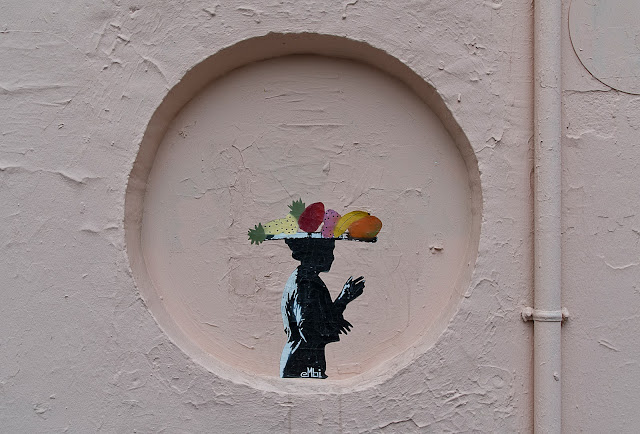Friday, 26 January 2024: Morning run - the City of Arts & Sciences route: Writer Azorin St., Realm of Valencia Ave., Mayor Reig St., Institute of Workers of Valencia Ave., cut-through to Ave. of the Silver, Ausiàs March Ave., Manuel Granero Square and home.
I’ve decided my Pierre Gonnord book, despite its diminutive size, was a pretty good purchase after all. The images are beautifully reproduced. They bear repeated viewing. And it was published in 2017 so includes some fine portraits from later years that weren’t in the book I originally ordered.
After lunch-dinner - roast pork with all the fixin’s (well, some of the fixin’s anyway) - we rode down to the Turia near Torre de Serranos (one of the two surviving mediaeval wall towers) and found a bench in the sun - though filtered through trees.
The book I’m reading is an odd one, The Starless Sea by Erin Morgenstern. It’s a fantasy about a hidden underground world accessible through magical doorways from the real above-ground world. It’s filled with books and stories, a “starless sea” of honey, owl kings, cats and unusual people. Are they real or just characters in stories? The main protagonist is a graduate student who stumbles on a mysterious book about the place that he finds in his university’s library. It’s definitely not my usual fare, but it’s amusingly written.
Underground seems to be a theme with me anymore. Since I started reading The Starless Sea, I’ve read a New Yorker article about a Spanish woman who lived for 500 days, totally on her own, with very little outside contact, in a cave a couple of hundred feet below ground. And then today, I was reading a story in The Paris Review - oooh, ain’t I getting fancy! - about a mother’s relationship with her rebellious teenage son. In the final, apparently metaphorical scene, they explore a cave together that they’ve accessed through a deep sinkhole in the middle of their unnamed community. And then, there was nature writer Robert MacFarlane’s fabulous Underland, which I read a few years ago, about various underground environments he’d researched and explored.
After the sun got too low to provide any real warmth, we walked up into the city and meandered around the narrow streets in something like the aimless way I do when I’m on my solo outings. By the end of it, though, Karen’s knee was giving her grief, so we headed, very slowly and gingerly, home for the evening.
 |
| Carmen streetscape: note the crabby-looking evil twins in black |
 |
| Cluttered Carmen antique shop |
Saturday, 27 January 2024: Fast walk this morning: a modified and elongated train station route that took me into some fairly mean streets west of Joaquin Sorolla station - dim, narrow streets of down-market apartment buildings. Not mean in the sense of threatening thugs on every corner - nothing as bad as our city centre! - just a slightly down-at-heels working-class neighbourhood.
Our life here has settled into easy-going routines. We hang around indoors in the morning, reading the papers and, in my case, magazines, or blogging. Around noon or a little after, the sun hits our juliette balcony and we squeeze into the little chairs and sit out there, reading or, in my case, sometimes, working on my cryptic crosswords, and bake in the sun. Then comes lunch-dinner.
Today, for the first time in a few years, I made us spaghetti carbonara. Karen has been experimenting with something called resistance starch as part of her anti-diabetes diet. The idea is that you cook the pasta - in this case, but it works with rice and potatoes too - the night before, refrigerate it, then heat it up the next day. The glucose hit, for reasons that I don’t really understand, is much, much lower. I couldn’t get pancetta so we had to make do with bacon, but it was still pretty good.
Lunch-dinner is followed by a walk or bike ride. Today, Karen wanted me to choose where we went and I chose walking down Carrer de Ciril Amaros, a posh shopping street in the Eixample neighbourhood, to the Pont del Mar bridge. She didn’t make the obvious objection that we’d just done that a couple of days before, so off we went.
The shops were mostly closed, it being siesta, but it’s still the most pleasant street for walking in this direction to this destination. It wasn’t quite as warm today, or sunny, but it was still nice, about 18C. We found a stone bench about halfway along the bridge and settled in. The sun came out. We were startled every 20 minutes or so by cannon-like booms - a firework of some kind - but could never figure out what it was about. We read our books. I took more cheeky candids of people sunning themselves below in the park - my not-so secret agenda for the day.
Then we walked home by a different route so Karen could test her blood sugar two hours after eating. It was within the acceptable range. We’d had pasta before done this way, but never as the main dish. So good result.












































